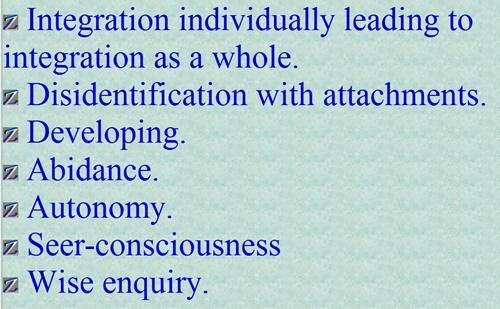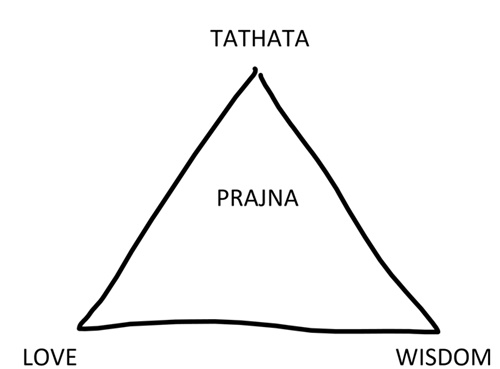Nicola Amadora has propelled zandtao towards prajna ousting him out of his egoic World Cup indulgence. Watch Batgap and her Power Reclamation interview as words for women.
Through Real Love zandtao had started using prajna as love-wisdom, but with the work with Stephen on a secular path zandtao had lost the prajna perspective. However awakening is the awakening of prajna – awakening of love-wisdom, that is what zandtao had forgotten. Towards prajna – love-wisdom we need a core practice of:-

These core components are more concerned with what is not in the practice than being the practice themselves ie are they missing? They also suggest a secularisation of prajna or love-wisdom, the investigation of secular was the purpose of the book with Stephen – A Secular Path?
Love-wisdom suggests two emphases:-
 Loving wisdom Loving wisdom
 Wise loving Wise loving
Zandtao sees this as the yin-yang of prajna. What we have in this world is an imbalance towards loving wisdom in which the prevailing ego is intellectual and the world lacks love or compassion as a motivation. This ego takes on the kilesas, and we have the “cement of patriarchy” Nicola spoke of. Paraphrasing Nicola loving wisdom and wise loving are not different but institutionally the emphases are very different. Nicola walks the talk of Mother Teresa, the institutions protect wisdom, provide refuges and teachings; in their desire to protect the knowledge they end up tacitly supporting patriarchy. Can the institutions do more for compassion in a world where there is such compassion-less harm?
There is another yin-yang of prajna – transcendence and immanence:-
 Immanent transcendence Immanent transcendence
 Transcendent immanence Transcendent immanence
Again there is no fundamental difference in this yin-yang except for the emphasis. In patriarchy this emphasis is towards transcendence – leading to the ego of spiritual bypassing. The patriarchy allows for a bypassing transcendence because such wisdom without love does not threaten the patriarchy. But such bypassing is not prajna. It might be a step towards prajna - that is for the individual seeker to decide, but compassionless bypassing is not the path. There is a need for transcendence - going beyond conditioning, but this going beyond cannot be separation – permanently up a mountain; transcendence sees the need for compassion – walking the talk.
But unwise love as bill knows is not prajna either. What we have with the deep feminine is an emphasis moving to love. And there is clearly a need for love in the world because love can end patriarchy. But what we need is for the institutions to work on love – to build up the love component of prajna, and if that love of prajna leads to the need for confronting patriarchy rather than working within patriarchy then that decision has to be made by our genuine leaders.
Much of zandtaomed’s work up to autonomy – the prajna portal – was guided by the institutions of Theravadin Buddhism; zandtaomed’s current Dhamma practice comes from Buddhadasa’s MwB ("Mindfulness with Breathing" by Buddhadasa Bhikkhu). Bill learnt from Harnham, recalls studying Ajaan Chah before retirement, and zandtao’s inner guide chose Buddhadasa in retirement – although from his Theravada origins Buddhadasa advocated non-existence of religion. Theravada was one of the attractions to bill’s retirement in Thailand. Yet Theravada has all the ahimsa practices involved in the Ajaan Brahm and Bhikkhuni Ordination of 2009 - thoroughly researched with references on this site together with a sympathetic view of Theravadin institutional compromises. This incident brings zandtao shame every time he speaks of his grounding in Theravada, and he deeply questions the institution that continues with this approach.
Prajna brings with it the wisdom to accept the pain of love and move on to embrace love and all its pain. When prajna sees the world it cries, the love rages at patriarchy yet it loves life. Raging at patriarchy brings with it pain but prajna for zandtao means exposing patriarchy for what it restricts spiritually. How much must the love of prajna fight to exist within patriarchy – to fight to overcome the patriarchal conditioning that to a greater or lesser extent most people accept?
And next? What does the deep feminine mean for zandtao? How can zandtao develop the yin-yang of prajna?
The next day came this. “Knowing and seeing the way things are” was a phrase that was central to the Secular Path? Why isn’t it “Knowing, seeing and feeling the way things are”? This opens us up to a trinity of truth wisdom and love:-

This seems a perfectly good development of seer consciousness:-
 Seeing the truth Seeing the truth
 Knowing wisdom Knowing wisdom
 Feeling love Feeling love
But it raises a huge question concerning the Buddha as a man why wasn’t it “Knowing, seeing and feeling the way things are” in his first sutta. Zandtao does not have sufficient knowledge of the suttas to see a pattern, and it is with huge temerity he is forced to ask the question.
Another development came today concerning immanent transcendence –
Is it beyond conditioning? That is transcendence. Would it be better to use beyond conditioning but within the stream of consciousness? Zandtao has previously recognised the separation associated with “beyond”. He has used lokuttara before, but will stop using it because it suggests a separate place - it might be reasonable to consider lokuttara a state of mind as state of mind is part of consciousness. For zandtao lokuttara is not a separate place, a beyond place, it is a state of transcended mind within the stream of consciousness of which the world of conditioning is separate, but it would be so easy to think of lokuttara as a concept of separation.
This brings zandtao to detachment because it would also be easy to think of detachment as a concept of separation, non-attachment is much better. Within immanence there is non-attachment. Again zandtao has in the past been developing this detachment within the stream of consciousness but the word detachment potentially has separation within it.
It is worth discussing zandtao’s understanding of yin-yang – very limited.

|
The symbol represents a totality of feminine and masculine, within the feminine there is masculine and vice versa. For zandtao this means that there is not a masculine or feminine way but always some form of combination. Zandtao has not studied what is considered feminine and masculine – somewhat embarrassingly as he was macrobiotic. |
This means that within bill, zandtaomed and zandtao there has been a partial balance of masculine and feminine throughout his life. He has the feeling that the masculine has decreased and the feminine increased as he has aged, but it is just a feeling – no examination of what is considered masculine and feminine. When younger his sex drive was stronger, and he was more conditioned by the patriarchy. Now thankfully the sex drive is minimal, and he hopes to have moved beyond patriarchal conditioning yet within the state of consciousness.
Undoubtedly zandtao is inclined towards the masculine emphasis of immanent transcendence – loving wisdom, although he is grateful for Nicola’s propelling towards the feminine; his work on spiritual love in Real Love happened before he met Nicola at Batgap. Already his teaching has included conscious awareness of masculine bias, and therefore sampajanna.
This leads to a question that he cannot answer concerning conditioning. When does the feminine and masculine start? When does feminine and masculine spirituality start? Can it be called spirituality if it is not sunnata? This then brings in the question of race, is there a racial spirituality? This is a headbanger that cannot be answered - zandtao-avyakata, but needs some investigation. Given that zandtao consciousness can never be sunnata, it is reasonable to recognise that there is feminine spirituality or consciousness as well as masculine spirituality or consciousness exemplified in transcendent immanence and immanent transcendence. Given the bias of living in patriarchy with patriarchal conditioning it is necessary to promote the bias of transcendent immanence and wise loving, although in theory the path would indicate the equivalent immanent transcendence and loving wisdom for a male.
Zandtao does not understand the current identity questions but respects the right for people to be free to choose their identity. With 100% trust in the path zandtao does not understand the need for change in gender except for the patriarchy. Given the yinyang it would be perfectly natural for different feminine/masculine balances in each individual. Given the patriarchy people whose balance is not reflected in their bodies might choose to change their bodies so that they can be treated appropriately. But isn’t this a reflection of patriarchal bias? Why can’t we express who we are – feminine in a masculine body? Zandtao trusts in the path, if we follow our paths maybe this need to change genders will dissipate? If this is offensive zandtao apologises. Zandtao would welcome clearer understanding of the experiences of these people, and respects the right to choose first especially given the tremendous pressures of patriarchy. But he is confused as he accepts Idappaccayata-Paticcasamuppada.

|



 Zandtao Meditation page
Zandtao Meditation page
 Advice from Zandtaomed
Advice from Zandtaomed